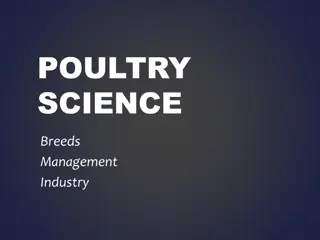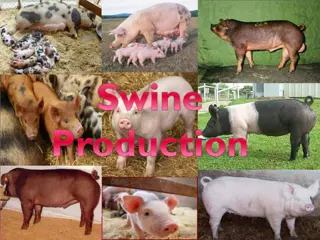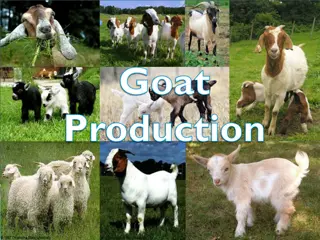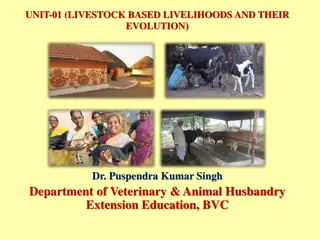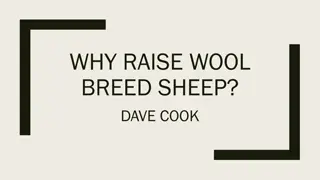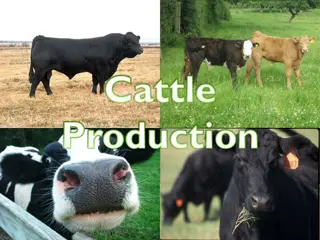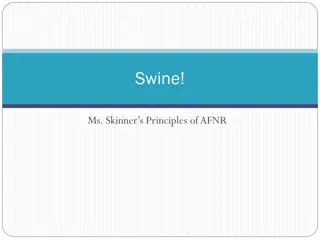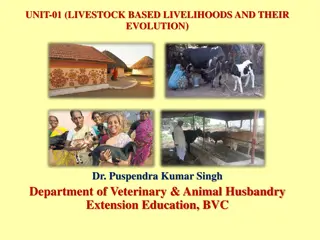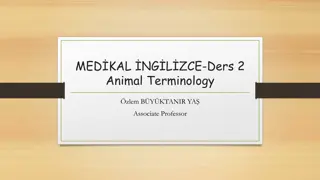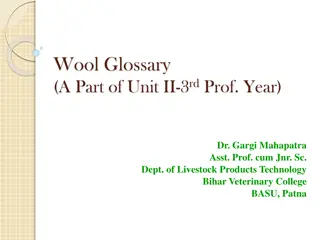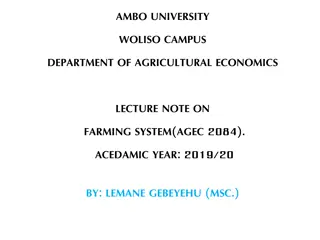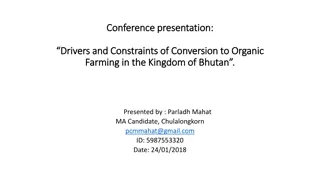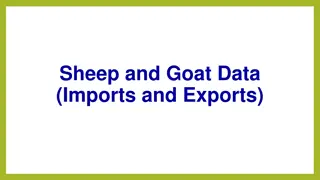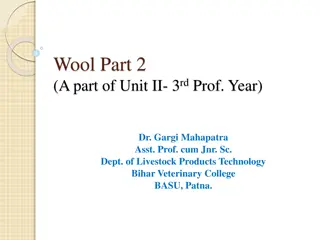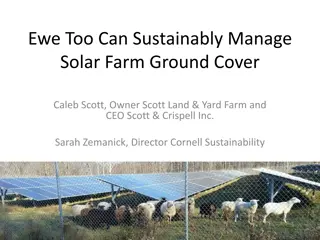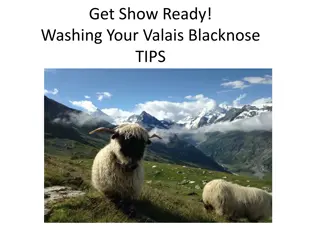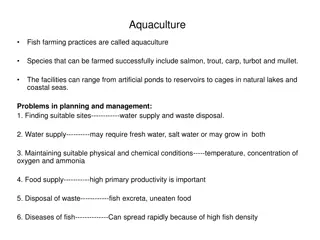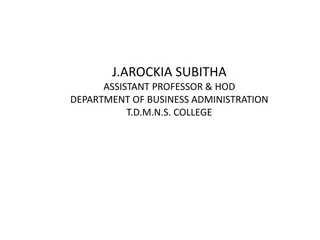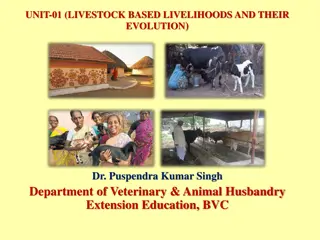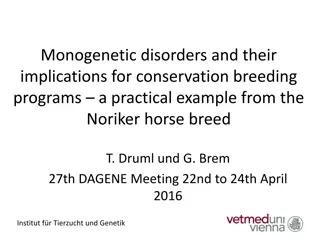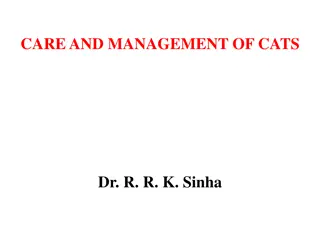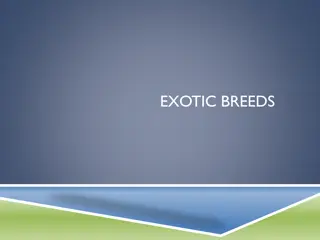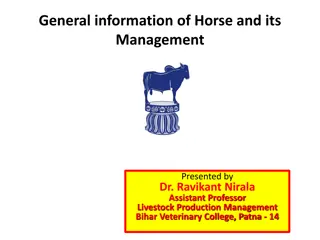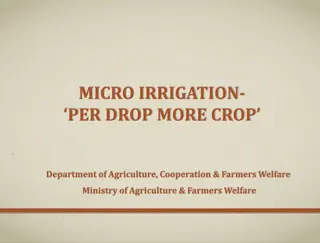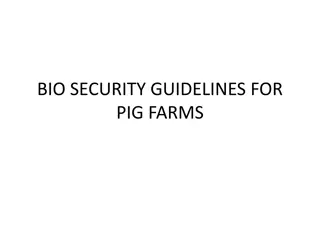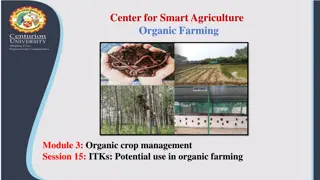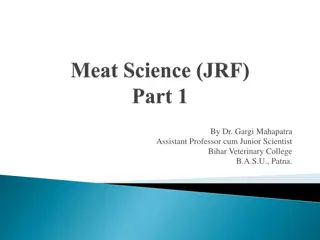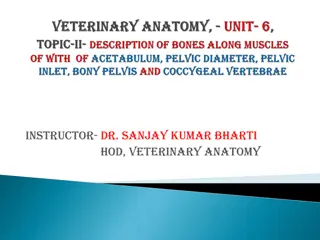Sheep Farming Essentials: Terminology, Breeds, and Practices
Explore the fundamental aspects of sheep farming including terminology, breeds like Merino and Rambouillet, and essential practices such as lambing, fleece collection, and managing a flock. Understand key concepts like prolificacy and fine wool production in this comprehensive guide to sheep husbandry.
Download Presentation

Please find below an Image/Link to download the presentation.
The content on the website is provided AS IS for your information and personal use only. It may not be sold, licensed, or shared on other websites without obtaining consent from the author. Download presentation by click this link. If you encounter any issues during the download, it is possible that the publisher has removed the file from their server.
E N D
Presentation Transcript
OBJECTIVES Terminology Breeds Management Practices Feeding and Nutrition Animal Behavior Animal Growth and Development Animal Health Evaluation
Ram A male that is sexually mature Young males are called ram lambs
Ewe Sexually mature female Young females are called ewe lambs
Lamb Young female or male
LAMBING The act of giving birth
FLEECE Wool of a sheep
FLOCK Herd or group of sheep
MUTTON Meat from sheep over one year of age
PROLIFICACY Ability to produce multiple offspring
MERINO Originated in Spain Most dominant breed in the worldwide sheep industry Typically smaller than other wool breeds White faced breed
RAMBOUILLET Originated in France Dominant range ewe in the western United States White-faced breed that is not extremely prolific under range conditions
BARBADO Developed in Texas Cross of Barbados Blackbelly and Rambouillet Tan, tan with a pale or black belly, or pied Primarily used as trophy game due to its large curled horns
COLUMBIA Developed in the United States Foundation of Lincoln rams on Rambouillet ewes Largest of the crossbred breeds White faced, polled breed
DORSET Originated in England Horned and polled strains Ability to breed out of season White-faced sheep that produce a light shearing, open fleece
HAMPSHIRE Originated in England Rapid growth and muscularity Dark brown to black face and legs with a wool cap on head
FINNSHEEP Originated in Finland Most noted for their incredible prolificacy (mature ewes produce 3+ lambs) Very poor fleeces and are slow growing and light muscled Require intensive management
SOUTHDOWN Originated in England One of the oldest sheep breeds Medium to small sized with light brown face and legs Produce meaty, light weight carcasses Low maintenance breed
SUFFOLK Originated in England Black head and legs which are free of wool Alert, active sheep that grow very fast and produce lean, muscular carcasses
LINCOLN Originated in England Heaviest breed in the world Face, ears, and legs are covered with wool White faced and polled
METHODS OF IDENTIFICATION Ear Tags Tattoos Ear notching Neck chains or straps
Ear Tags Most common identification method Come in many different sizes and designs
Tattoo Best permanent form of identification Does not harm the animal s appearance or reduce value in any way Disadvantage: tattoos cannot be read from a distance
Ear notching Commonly used for simple differentiation. Denotes birth type and/or week of birth. Marks ewes for culling.
Neck Chains or Straps Least used form of identification Have numbered tags that correspond with animal identification Disadvantages: choking, not permanent, difficult to see in groups
DOCKING AND CASTRATION Best performed at the same time. All lambs should be docked before 2 weeks of age. Males that will not be used for breeding should be castrated before 4 weeks of age. Docking methods: knife, elastrator, emasculator, Hot iron Castration methods: Knife, Elastrator, Burdizzo, All-in-one Castrator
CRUTCHING AND FACING Crutching: shearing of the reproductive area and mammary system of ewes prior to parturition. Facing: shearing of wool on face to help with vision
DRENCHING AND SPRAYING Drenching: administration of oral anthelmintic (dewormer) Spraying: topical removal of external parasites
Predator Control In addition to secure pens, some companion animals serve as effective protection Flock dogs such as the Great Pyrenees, llamas, and donkeys
FACILITIES 200 square feet per lamb recommended Overcrowding may cause lambs pick at each others wool resulting in bald patches. Facilities should provide protection from extremes in weather conditions
EXERCISE Exercising a lamb provides multiple benefits: Development of muscle Condition or feel of muscle Stimulation of appetite Proper finish or fat cover
EXERCISE Walking lambs on halter on level ground does not give them enough exercise to tone muscle. If lambs have a large area for exercise during the entire feeding program they may not need a forced exercise program
SHOW NEEDS Stiff brush for cleaning troughs Rope halter Hand shears Portable feed & water troughs Lamb blankets and/or socks Rake Shovel Trimming table measuring 45 long, 20 wide & 18 tall Clippers Wool card
FEEDING Elevate feeders to reduce waste and improve cleanliness Feed to aid in the development of leg and loin muscle. Feed good quality grass, sorghum, or alfalfa hay
FEEDING CONTINUED Start feeding grain in small amounts to allow the digestive system to adjust to the higher concentrations. about to pound of grain per day Increase feed gradually to approximately 2 pounds of grain and 2 pounds of hay per day. After two weeks lambs should be on full feed.
FEEDING SCHEDULE Twice a day, within 15 to 30 minutes of a regular schedule.
WATER Provide clean, fresh water at all times The most important nutrient
MINERALS Have free choice loose salt, and loose trace minerals available at all times *Be cautious of the copper level in sheep rations.* Accumulate copper in the liver more readily than other farm animals and are very susceptible to Cu toxicity (poisoning)
POINT OF BALANCE At the animals shoulder Stepping behind the point of balance will cause livestock to move forward. Standing in front of the point of balance will cause livestock to back up
FOLLOW THE LEADER When one sheep moves, the rest will follow To display this flocking behavior a group of five is usually necessary. This strong flocking and following behavior tends to make sheep easy to handle, relative to other livestock species
SOCIAL Very social animals; they need to see other sheep



